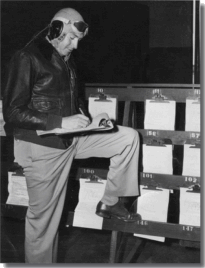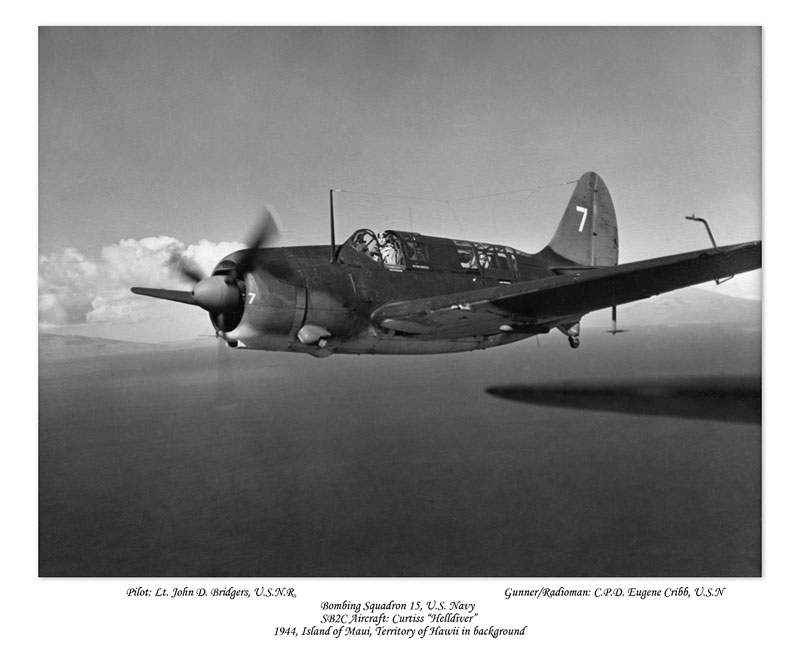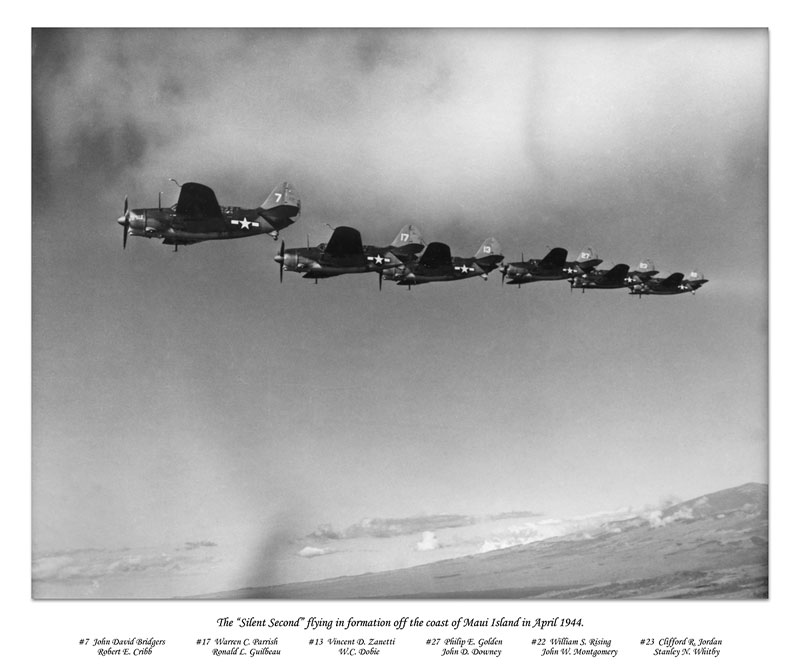Lt. (JG) John D. Bridgers, M.C., U.S.N.R. In Flight Refresher Training as Pilot (also Flight Surgeon) U.S.N.A.S., Corpus Christi, Texas -1951-
 |
Enlisting in the Naval Reserve in February 1941, John Bridgers served two tours as a carrier-based aviator in the Pacific theater during World War II. After completing medical school in 1950, he returned to active service for the Korean War, this time serving as a flight surgeon and closing out his active duty career with VX-3, an experimental air group, developing bombing tactics for carrier-based jet aircraft.
Like many of his generation, World War II had a significant impact on his later life. During the course of these years, he met his future wife, Edie, and the first five of their six children were born. In addition to a graduate education, his future profession and a new family, the Navy provided John David with a new name, "Jig" -- which over the years his children have morphed into Jigs.
During World War II, he flew almost 70 combat missions and was a member of VSB-42, VB-3, VB-5, VS-6, VB-13 and VB-15. Some 44 of his combat missions were flown with VB-15 and Air Group 15 from aboard the U.S.S. ESSEX. Other carrier assignments included the U.S.S. ENTERPRISE, the U.S.S. YORKTOWN, the U.S.S. SARATOGA, and the second U.S.S. HORNET (Essex-class) on its initial voyage from Norfolk through the Panama Canal to Pearl Harbor.
Jigs joined the Navy in the closing days of the biplane era and left active duty in the early days of the jet. Among the aircraft he flew were the SBC, F2F, F3F and N3N biplanes; the Brewster SBN, Northrop PT and Vought SB2U scout-bombers; the later SBD Douglas Dauntless and Curtiss SB2C dive-bombers; and finally the MacDonald F2H and an early jet aircraft by North American.

Campaigns and combat action included the Doolittle raid, the Battle of Midway, the Solomon Islands including flying out of Henderson Field on Guadalcanal, the Marcos Islands, Palau, the Marianas, Iwo and Chichi Jima, the Battle of the Philippine Sea, Formosa and the Battle of Leyte Gulf.
Commendations included four Air Medals for action in both Guadalcanal and Leyte Gulf, a Distinguished Flying Cross (see Lullaby Lane) and a Navy Cross for leading the attack on the CHITOSE at Leyte Gulf (see Where's Point X-ray?).
Over the last fifteen years Jigs has been jotting down anecdotes and profiles of the people he knew during his Navy years. These and other events are covered in these stories. The result is not a strictly historical account but rather a more intimate view of the war much as his previous writings, Crick and The Shaggy Dog Chronicles, are the history of his family as told through their stories.
However, unlike The Shaggy Dog Chronicles, these stories were not combined into a single, continuous narrative. They are individual vignettes each meant to stand on their own yet together capturing the sweep of the Pacific War.
Safely Afraid, the first of these stories, starts in the spring of 1941 and describes the circumstances that lead to Jigs' enlistment in the Naval Reserve, starting with his final days in college and running through to his reporting to duty in February of 1941.
There But For The Grace of God describes the early Grumman F2F and F3F bi-planes and their proclivity to land "wheels up."
On The Traveling Squad covers flight training and the first few months of the war with descriptions of Jigs' arrival at Pearl Harbor in February shortly after the December attack, the launching of the Doolittle raid as viewed from the U.S.S. ENTERPIRISE and the loss of the U.S.S. YORKTOWN during the Battle of Midway.
Midway is a compilation of miscellaneous vignettes which together with On The Traveling Squad give one a front row seat to the events of June 4, 1942.
Shadow Boxing In The Coral Sea picks up after Midway with Jigs' assignment to Scouting Squadron SIX aboard the U.S.S. SARATOGA and covers VS-6's time in the southwest Pacific including a stint on land at Henderson Field on Guadalcanal (memorialized in the April 12, 1943 issue of Life Magazine) and culminating in the re-designation of the group as VB-13 and Jigs' return to the states in 1943.
Big Foot is a short anecdotal tale of Jigs and his fellow VS-6 pilots' role in the development of fashionable footwear for Naval aviators and their influence on Bill Chase, an early figure in the development of radar communications.
The Metabolism of Humiliation recounts a humorous misadventure while Jigs was stationed in Hawaii with Scouting Squadron SIX.
Alarming another anecdotal tale from VS-6 and Air Group 3 and the flying of SBD's from aboard the U.S.S. SARATOGA while the US and Japanese fleets were "shadow boxing" off the coast of New Caledonia.
Bent Pinkie is the first of several stories covering the activities of Air Group 15. (The exploits of VB-15 are also the basis for the collection of poems entitled Teakwood Ballads.) This particular story introduces us not only to the air group's flight surgeon, Dr. Paul Maness, but tells of the strategies and personalities behind "Operation Forager" and how these events, in the summer of 1944, ultimately affected the fortunes of war for both Jigs and A.G. 15.
An Old House describes how the lives of two men raised in the very same house in a small North Carolina town intersected during the events that became known as The Battle of The Philippine Sea and The Marianas Turkey Shoot
Lullaby Lane, tells the story of Jigs escorting Scott Matthews back to the ESSEX after Matthews' plane was damaged in action. This good deed earned Jigs a Distinguished Flying Cross and a stern rebuke from David McCampbell, the Navy's top ace and the commander of Air Group 15.
Where's Point X-Ray? covers the Battle of Leyte Gulf and the historic days of October 24th and 25th, 1944 during which VB-15 flew three missions and is credited with the sinking of the MUSHASI and the CHITOSE (for which Jigs' was awarded a Navy Cross).
Flying Wing is a tribute to Jigs' enduring friendship with Warren Parrish, a childhood friend who -- by unlikely coincidence -- became his cabin-mate on the U.S.S. ESSEX and flew wing with him in "The Silent Second" of VB-15.
Down on the Suwannee is the story of Charles Bayard "Milt" Milton who as a Naval aviator was an ace with VF-15 and Air Group 15 and in retirement was the writer whose correspondence inspired Jigs to put pen to paper.
"Bean-Bag Barney" was the nickname of James W. Barnitz. He and Jigs served together on three occasions. First with VS-6 on the U.S.S. SARATOGA in the southwest Pacific, next with VB-15 first in Norfolk and later on both the U.S.S. HORNET and the ESSEX, and finally with the Operational Training Command in Jacksonville, Florida at the war's end.
Not Quite a Knight, is told through his encounters with Sumner Roulon-Miller, Whitehall Reid and Edith Hamrick and spans from VB-15's early days in Norfolk through to the final days of the war and beyond.
Finally in Mufti covers Jigs' return to active duty as a Flight Surgeon during the Korean War ending with his final assignment to VX-3 in Pomona, New Jersey.
Purpose Night finds Jigs' moonlighting in the local emergency room while stationed in Pensacola, Florida.
Just Us Chickens is a humorous account of the medical practice and procedures Jigs' encountered while serving in the Navy in the panhandle region of Florida during the early 1950's.
Big Feet and Weak Eyes returns to the size of Jigs' feet and their role in his life-long friendship with and respect for Dr. Tom Duane, starting with their days at the U.S. School of Naval Aviation in 1950 until Tom's death in the early 1990's.
The Plane That Grand-Dad Flew takes a passing comment overheard in the summer of 1976 while viewing an SBD aircraft on display at The Smithsonian Air and Space Museum in Washington, D.C. and uses it as a spring-board for a quick history lesson on Naval aviation from the Wright Brothers through World War II.
Golden Gatherings brings us full circle to the present day by joining with many of these same participants and looking back fifty years.
One important story we've just recovered is that of Niles Raymond Siebert, Jigs' friend and cabin-mate for almost three years of the war. "Sieb" was lost over Guam in 1944. Jig and Edie named their fourth son, Raymond Siebert, after him and these stories are dedicated to his memory.
Carl Bridgers
Berkeley, CA
May 2002

|
